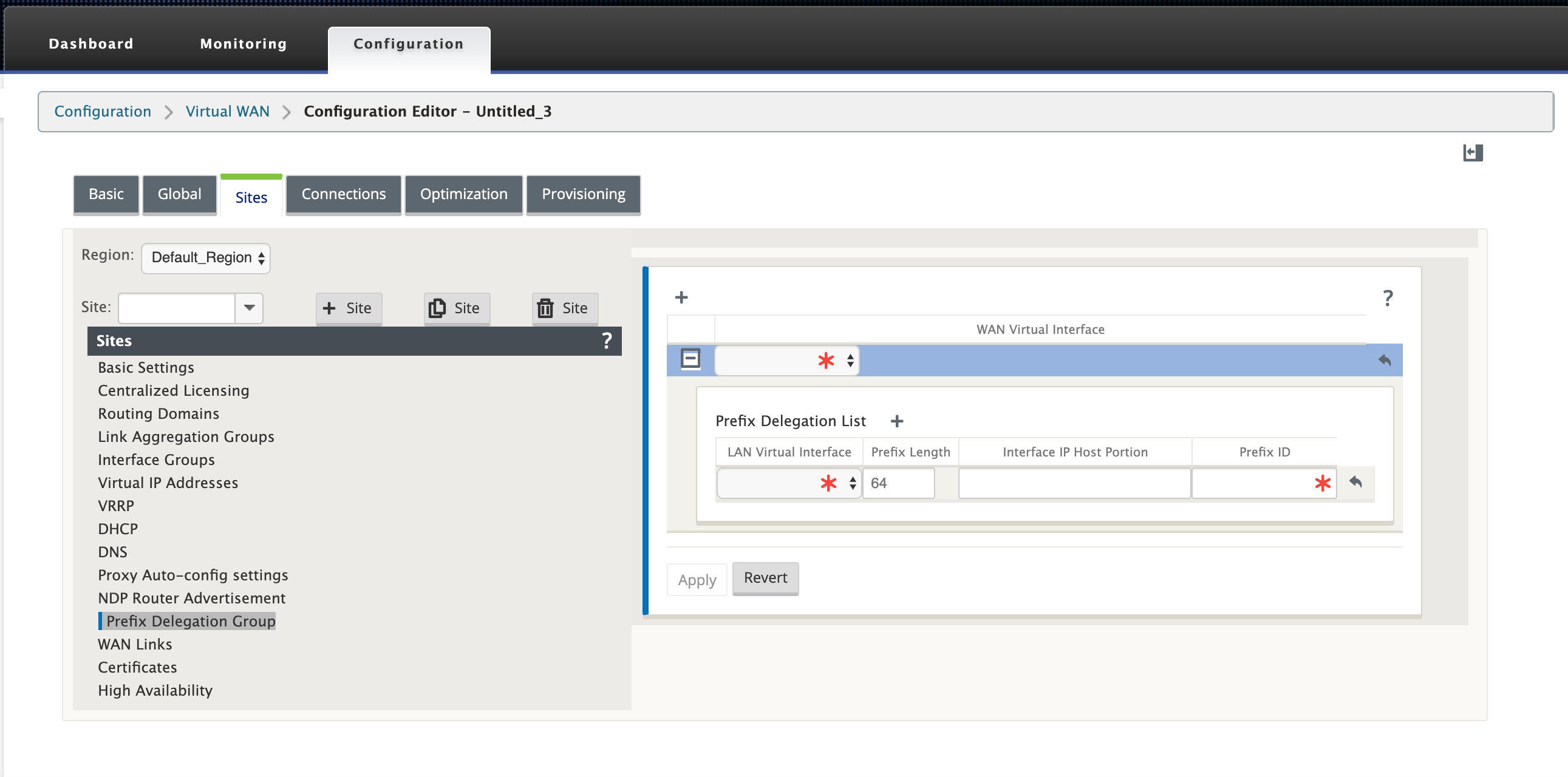-
Configuration guide for Citrix Virtual Apps and Desktops™ workloads
-
Citrix SD-WAN Orchestrator™ on-premises configuration on Citrix SD-WAN appliance
-
-
NDP router advertisement and prefix delegation group
-
This content has been machine translated dynamically.
Dieser Inhalt ist eine maschinelle Übersetzung, die dynamisch erstellt wurde. (Haftungsausschluss)
Cet article a été traduit automatiquement de manière dynamique. (Clause de non responsabilité)
Este artículo lo ha traducido una máquina de forma dinámica. (Aviso legal)
此内容已经过机器动态翻译。 放弃
このコンテンツは動的に機械翻訳されています。免責事項
이 콘텐츠는 동적으로 기계 번역되었습니다. 책임 부인
Este texto foi traduzido automaticamente. (Aviso legal)
Questo contenuto è stato tradotto dinamicamente con traduzione automatica.(Esclusione di responsabilità))
This article has been machine translated.
Dieser Artikel wurde maschinell übersetzt. (Haftungsausschluss)
Ce article a été traduit automatiquement. (Clause de non responsabilité)
Este artículo ha sido traducido automáticamente. (Aviso legal)
この記事は機械翻訳されています.免責事項
이 기사는 기계 번역되었습니다.책임 부인
Este artigo foi traduzido automaticamente.(Aviso legal)
这篇文章已经过机器翻译.放弃
Questo articolo è stato tradotto automaticamente.(Esclusione di responsabilità))
Translation failed!
NDP router advertisement and prefix delegation group
NDP router advertisement
In an IPv6 network, SD-WAN appliance periodically multicasts Router Advertisement (RA) messages to announce its availability and convey information to the neighboring appliances in the SD-WAN network. The router advertisements include the IPv6 prefix information. Neighbor Discovery protocol (NDP) running on SD-WAN appliances uses these router advertisements to determine the neighboring devices on the same link. It also determines each other’s link-layer addresses, find neighbors, and maintain reachability information about the paths to active neighbors.
To configure the NDP router advertisement,
-
In the Configuration Editor, navigate to Sites > NDP Router Advertisement.
-
Click + and select one of the configured virtual interfaces from the Virtual Interface drop-down list.
-
Select the Enable Advertisement check box to enable sending periodic router advertisements and responding to Router Solicitations for the selected virtual interface.
-
Specify the maximum, minimum, and router lifetime intervals.
- Max Interval: The maximum time (in seconds) allowed between sending periodic unsolicited multicast router advertisements.
- Min Interval: The minimum time (in seconds) allowed between sending periodic unsolicited multicast router advertisements.
- Router Lifetime: The time (in seconds) the router is considered valid by the hosts. 0 indicates the router cannot be used as the default router.
-
Select Managed Flag check box if IP addresses are available through DHCPv6 protocol.
-
Select Other Flag check box if the configuration information (other than the IP addresses) is available through the DHCPv6 protocol.
-
Specify the following values for the selected interface.
- Link MTU: The recommended Maximum Transmission Unit (MTU) for the interface.
- Reachable Time: The time (in milliseconds) the NDP protocol stays in the Reachable state.
- Retransmit Timer: The time (in milliseconds) between retransmission of Neighbor Solicitation messages when resolving an IP address or probing a neighbor.
- Hop Limit: The maximum number of hops to be included in the router advertisement.
-
Enter the details associated with the prefix.
- Prefix: The prefix and prefix length in Classless Inter-Domain Routing (CIDR) notation.
- Valid Lifetime: The time in seconds up to which the prefix is valid. -1 represents infinity which means the prefix remains forever.
- On-link: When selected the prefix is considered as local to the network.
- Autonomous Flag: When enabled the prefix is used by the host’s Stateless Address Autoconfiguration (SLAAC) to generate the IP address.
- Prefix Lifetime: The time (in seconds) up to which the prefix is considered as preferred.
-
Click Apply.
-
To configure more virtual interfaces for NDP router advertisement, click +.

Prefix delegation group
NOTE
Prefix delegation is not supported in Citrix SD-WAN 11.3 release.
Citrix SD-WAN™ appliances can be configured as a DHCPv6 client to request a prefix from the ISP using the configured WAN port. Once Citrix SD-WAN appliance receives the prefix, it uses the prefix to create a pool of IP addresses to cater the LAN clients. Citrix SD-WAN appliance then behaves as a DHCP server and advertise the prefix on the LAN ports to the LAN side clients.
To configure prefix delegation,
-
In the Configuration Editor, navigate to Sites > Prefix Delegation Group.
-
Click + and choose a configured WAN Virtual Interface on which the prefix is requested from the ISP.
-
Provide the following details:
- LAN Virtual Interface: Select one of the configured LAN virtual interfaces for which the prefix is requested.
- Prefix Length: The number of bits of a Global Unicast IPv6 address that are part of the prefix.
- Interface IP Host Portion: The host portion to be used for the interface IP address.
- Prefix ID: A unique identifier to identify the prefix delegation requests for the LAN interface.
-
Click Apply.
-
To configure more WAN virtual interfaces as part of the Prefix Delegation Group, click +.

Share
Share
This Preview product documentation is Cloud Software Group Confidential.
You agree to hold this documentation confidential pursuant to the terms of your Cloud Software Group Beta/Tech Preview Agreement.
The development, release and timing of any features or functionality described in the Preview documentation remains at our sole discretion and are subject to change without notice or consultation.
The documentation is for informational purposes only and is not a commitment, promise or legal obligation to deliver any material, code or functionality and should not be relied upon in making Cloud Software Group product purchase decisions.
If you do not agree, select I DO NOT AGREE to exit.